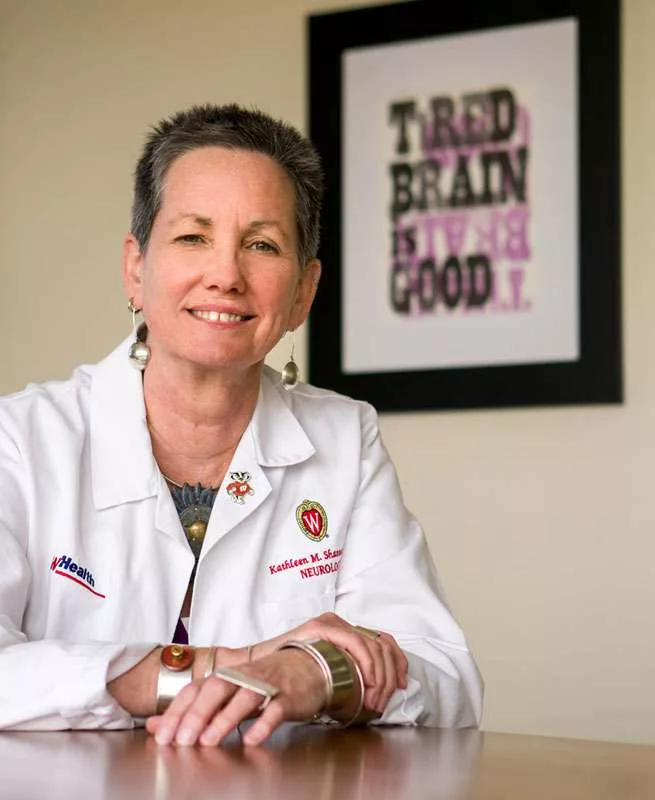‘Should I Get an MPH Degree?’ Patrick Remington Shares His Insights
The associate dean for public health reflects on his journey as a physician trained in preventive medicine and public health and offers advice for those considering the degree.
In her first year as chair of the University of Wisconsin School of Medicine and Public Health’s (SMPH) Department of Neurology, Kathleen Shannon, MD — a movement disorders specialist — has led efforts to earn center of excellence designation from the Huntington’s Disease Society of America for the UW Health Neurology Clinic.

It was the first such center of excellence in Wisconsin; the UW Health Muscular Dystrophy Clinic has since earned a similar status. The designation recognizes patient-centered care and means patients don’t need to leave Wisconsin for multidisciplinary care. Shannon’s department has started destination medicine clinics at UW Health at the American Center for patients with Huntington’s disease and those with epilepsy who are on a ketogenic diet. A clinic that treats neurological conditions in women is being planned.
Before she joined the SMPH, Shannon led multiple research studies on Parkinson’s and Huntington’s diseases at Rush University Medical Center in Chicago. She now is working to open similar clinical trials at the SMPH.
What led you to the movement disorders specialty?
When I was young, my Uncle John had Parkinson’s disease, and my siblings and I would watch him walk very slowly from the car to our door. One day, a miracle occurred. Uncle John was one of the first people in the nation to be treated with levodopa, and he could walk again! I never forgot that miracle.
What other challenges do your patients face?
There’s a lot of stigma associated with these inherited diseases. In the United States, maybe because of our society’s Puritanical origins, some people — unaware of their biases and misconceptions — place blame upon individuals who have genetic diseases.
Is it difficult to work in a field that has not had breakthrough treatments?
Well, I have never cured anyone, but I have helped countless people improve their quality of life. I am grateful for the long-term relationships I have with my patients and how their progressive diseases challenge me to rework their plans to make things better.
What about future treatments?
So far, the new medications in movement disorders are simply symptom modifiers. However, potentially disease-altering therapies are on the horizon. New multiple sclerosis drugs are monoclonal antibodies (MCAs), and researchers are studying the use of MCAs for Parkinson’s and Alzheimer’s diseases. Clinical trials are underway in Europe and Canada on the use of genesilencing therapies to block “messages” that help create the protein in Huntington’s disease. And a new study using CRISPR/ Cas9 gene editing in Huntington’s disease mouse models looks impressive. We need that gene during development but not in adulthood, so, potentially, we could edit it out before the disease appears in middle age.
Why is it so important to have more clinical trials here?
I think clinical trials are important because they distinguish our academic medical center. It’s beneficial for patients to go to a medical center that is studying the next generation of drugs, even if they are not going to participate in a clinical trial.
Some new drugs are crazy expensive!
Spinraza, which treats spinal muscular atrophy (SMA), costs $125,000 per dose, and the schedule for the first year costs $750,000. Some other new drugs aren’t miraculous, but that one is. Children with this condition don’t produce a protein necessary for motor nervous system development. A recent Grand Rounds described a 5-year-old child with SMA who required a ventilator, and a 1-year-old child with the same mutation who had started getting Spinraza at 3 weeks of age. Without the drug, such patients are paralyzed and never hit developmental milestones, such as walking. But the 1-year-old was running around and talking. Many questions remain, such as: How long should patients be treated? Once the nervous system develops, can patients stop treatment? These types of drugs are under development for many chronic diseases, including Alzheimer’s and Parkinson’s, and it will be a challenge to find ways to pay for the therapies.
What’s the biggest challenge facing neurology in Wisconsin?
We must make sure Wisconsin residents, including those in rural areas, get good care. We face a major shortage of neurologists and are looking at ways we can care for as many people as possible. Our Telestroke Program lets us do real-time consults with hospitals around the state, and we’re adding new stroke neurologists so we can expand this service to more rural areas. Stroke is another area that has seen remarkable progress!
Why should medical students consider entering neurology?
Neurology offers many types of practice models, so there is something for everyone. This field is a good choice for people who love to solve mysteries and work in partnership with patients to arrive at the best treatment at each step along the way.
How’s life in Madison compared with Chicago?
I traded a 90-minute daily commute for a five-minute walk to work, which makes me happier. People around me seem happier, too, because they live in a beautiful, healthy community. I miss Chicago’s diversity, but Madison and the university are working hard to welcome a more diverse population. Madison is a great place to live and work.